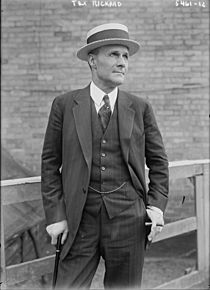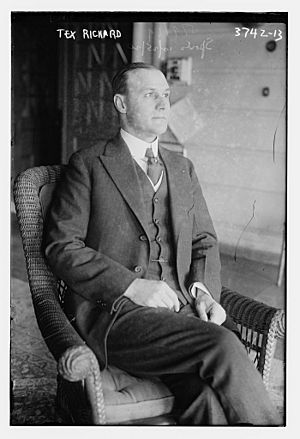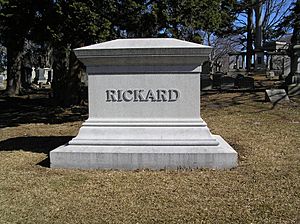Tex Rickard facts for kids
Quick facts for kids
Tex Rickard
|
|
|---|---|
 |
|
| Born |
George Lewis Rickard
January 2, 1870 Kansas City, Missouri, U.S.
|
| Died | January 6, 1929 (aged 59) Miami, Florida, U.S.
|
| Occupation |
|
| Years active | 1896–1929 |
| Known for |
|
| Spouse(s) |
|
| Children | 3 |
George Lewis "Tex" Rickard (January 2, 1870 – January 6, 1929) was a famous American boxing promoter. He was also the founder of the New York Rangers hockey team and built the third Madison Square Garden in New York City. During the 1920s, Tex Rickard was a top promoter, known for making boxing popular with huge audiences. He was one of the first to see the power of having "star" athletes. Rickard also owned several entertainment spots, including saloons, hotels, and casinos, mostly in Alaska, Nevada, and Canada.
Contents
Tex Rickard's Early Life
Rickard was born in Kansas City, Missouri. When he was four, his family moved to Sherman, Texas. After his father passed away, his mother moved to Henrietta, Texas. Rickard became a cowboy at age 11.
At 23, he was elected marshal of Henrietta, Texas. This is when he got his famous nickname, "Tex." On July 2, 1894, Rickard married Leona Bittick. Their son, Curtis L. Rickard, was born in February 1895. Sadly, both Leona and Curtis died shortly after.
Adventures in Alaska
In November 1895, Tex Rickard went to Alaska because gold had been found there. He was in the area when the big Klondike Gold Rush started in 1897. Tex and his partner, Harry Ash, found gold claims and later sold them for almost $60,000.
They then opened a saloon, hotel, and gambling hall called The Northern in Dawson City, Canada. Tex lost his share of The Northern through gambling. He later worked as a poker dealer and bartender. During this time, he and Wilson Mizner started promoting boxing matches. In 1899, Tex left for the Nome Gold Rush in Alaska.
Tex Rickard was a friend of Wyatt Earp, who also loved boxing. They even owned competing saloons in Nome for a short time. In 1902, Rickard married Edith Mae Haig. They had a daughter, Bessie, who died in 1907. Edith Rickard passed away in 1925.
Promoting Fights in Nevada
By 1906, Rickard was running The Northern saloon and casino in Goldfield, Nevada. There, he promoted a professional boxing match between Joe Gans and Battling Nelson. This fight brought in a record amount of money, nearly $70,000. A year later, Rickard opened another Northern Hotel in Ely, Nevada. He also started the Ely Athletic Club and owned mining properties.
In 1909, Rickard won the right to promote the world heavyweight championship fight. This was between James J. Jeffries and Jack Johnson. Rickard planned the fight for July 4, 1910, in San Francisco. However, due to opposition, he moved it to Reno, Nevada. Rickard made about $120,000 profit from this fight, which Johnson won.
Cattle Ranching in South America
On February 18, 1911, Tex Rickard announced he was leaving the boxing business. He sailed to Argentina to start a cattle ranch in Paraguay. He bought a huge amount of land, between 270,000 and 327,000 acres. At its best, his ranch had about 1 million acres and between 20,000 and 50,000 cattle.
In 1913, Rickard's ranch was involved in a political issue between Paraguay and its neighbors. Two of his employees were killed by soldiers. That same year, Rickard joined Theodore Roosevelt on part of an expedition. The cattle business did not succeed by the end of 1915, and Rickard lost a lot of money.
Hockey and the New York Rangers
According to NHL.com, in 1924, Tex Rickard was the first person to call the Montreal Canadiens "the Habs." He reportedly told a reporter that the "H" on their jerseys stood for "Habitants."
After the New York Americans hockey team did well in the Garden's first year, the Madison Square Garden Corporation decided to create its own team. This new team was nicknamed "Tex's Rangers" and later became known as the famous New York Rangers.
Return to Boxing Promotion
In 1916, Rickard came back to the United States and to boxing. On March 17, 1916, he promoted a fight between Jess Willard and Frank Moran at Madison Square Garden in New York City. The money earned from tickets, $152,000, set a new record for an indoor event.
Rickard promoted the July 4, 1919, fight between Jess Willard and Jack Dempsey in Toledo, Ohio. This fight earned about $452,000, and Rickard made a profit of $100,000.
After this, Rickard worked to set up a title match between Dempsey and Georges Carpentier. The Jack Dempsey vs. Georges Carpentier fight happened on July 2, 1921, in a special arena in Jersey City, New Jersey. This fight drew a record crowd of 90,000 people. It was the first boxing match to earn over a million dollars, bringing in $1,789,238. It was also the first world title fight to be broadcast on radio. Rickard's profit from this event was reported to be $550,000.
In July 1920, after boxing became legal again in New York, Rickard leased Madison Square Garden for ten years. He promoted many championship and amateur boxing matches there. His biggest earnings at the Garden came from the Jack Dempsey–Bill Brennan fight in December 1920. Rickard also hosted other events, like six-day bicycle races, and built the world's largest indoor swimming pool at the Garden.
Rickard faced some legal challenges but was found not guilty of the main charges in March 1922.
On May 12, 1923, Rickard promoted the first boxing event at Yankee Stadium. It attracted 60,000 people, a record for boxing in New York at the time. The money earned, over $182,000, was given to a charity.
On September 14, 1923, Rickard promoted his second fight that earned over a million dollars. About 100,000 people watched the Jack Dempsey vs. Luis Ángel Firpo fight at the Polo Grounds.
In 1925, Rickard was fined for legal issues related to showing fight films across states.
In 1926, Rickard promoted the Jack Dempsey–Gene Tunney fight in Philadelphia. This fight drew a world record crowd of 135,000 and earned a record $1.895 million. He also promoted their rematch, known as The Long Count Fight, on September 22, 1927, in Chicago. This fight was the first to earn over $2 million ($2.658 million) and had the first $1 million prize for the fighters. Rickard reported that between 1924 and 1926, his events earned $7.79 million.
Building Madison Square Garden
On May 31, 1923, Rickard started a company to build and run a new sports arena in New York City. In 1924, he bought a city block on Eighth Avenue. He also got the rights to the name "Madison Square Garden." The new arena opened on November 28, 1925. The first major event there was a boxing match on December 11, 1925, which drew a record indoor crowd of 20,000. This event also broke the record for money earned at an indoor boxing event.
In January 1926, Rickard bought a radio station, WWGL, and moved it to the Garden, renaming it WMSG.
Other Business Ideas
Rickard wanted to build more "Madison Square Gardens" across the country. In 1927, his group signed a lease for a sports arena in Boston. The Boston Garden opened on November 17, 1928.
In 1929, Rickard and George R. K. Carter opened the Miami Beach Kennel Club, a greyhound racing track. They also planned other projects, like a jai-alai court and a horse track. Rickard hoped to one day build a hotel and casino that would be as grand as those in Monte Carlo.
Tex Rickard's Family Life
Rickard met Maxine Hodges, a former actress, at the Dempsey–Firpo fight. They married on October 7, 1926. Their daughter, Maxine Texas Rickard, was born on June 7, 1927.
On December 26, 1928, Rickard traveled to Miami Beach, Florida. He was working on plans for a boxing match and attending the opening of his new greyhound track. On New Year's Eve, Rickard became ill with appendicitis and had surgery. Tex Rickard died on January 6, 1929, due to problems after his surgery. He was buried in Woodlawn Cemetery in the Bronx, NY.
Images for kids






